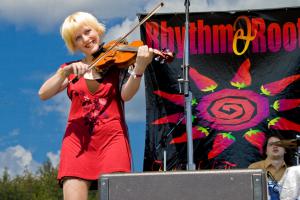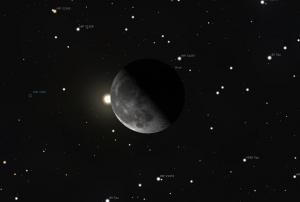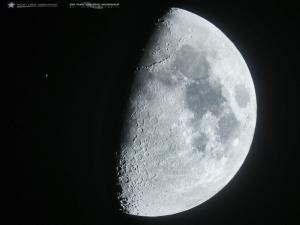
Stargazing Night - Rhythm and Roots 2015
- Where:
- Frosty Drew Observatory
- When:
- Friday September 4, 2015 at 7:30 p.m.
- Cost:
- $1 Suggested Donation per Person
Tonight's forecast is calling for mostly clear skies with periods of partly cloudy conditions. Additionally, we can expect 6-11mph winds with gusts as high as 21mph. Gusts over 16mph are a bit high for the Observatory telescopes though we should be OK to go if we play it safe. The 59% waning gibbous Moon will rise at 11:26 p.m. and though bright, it will put on quite a show as it passes in front of Aldebaran, the brightest star in the constellation Taurus. We also have the fabulous Rhythm and Roots music festival happening in Ninigret Park this weekend. Rhythm and Roots will bring killer tunes, hundreds of people, and a step up on the rowdy scale. Setting us up for an excellent night to be at Frosty Drew!
We plan to open the Observatory at 7:30 p.m. tonight. In the Observatory, telescopes will feature an early view of Mercury, which is at maximum eastern elongation and showing off a sexy 55% gibbous phase. Once Mercury sets, we will head over to Saturn, which will be sporting a fabulous view of its rings and up to five moons. Over the course of the night, telescopes will feature binary stars, nebulae, star clusters, and of course the stunning gibbous Moon. Once 11:50 swings around, we will setup for a view of the Moon visibly occult the bright star Aldebaran, and again 45 minutes later to observe Aldebaran emerge from behind the Moon. The Sky Theatre and Nature Center will remain closed tonight as the music festival will bring out too many people to accommodate in our Sky Theatre. We will stay open late, probably until dawn, hanging out with all the excellent music festival patrons.
Overall, tonight looks to be an OK night. The Rhythm and Roots festival will bring quite a bustle to the Observatory and will also bring a step up in artificial lighting. If super dark skies is your digs tonight, you may want to sit this one out. Otherwise, this is our rowdy weekend of the year and it is certainly an experience for those visiting. Please note that you DO NOT have to pay for Rhythm and Roots tickets to visit Frosty Drew tonight. When traveling through the park, you will be stopped by the music festival parking staff. Kindly inform them that you are visiting Frosty Drew Observatory and they will let you through. If a parking attendant tells you the Observatory is closed, kindly tell them that you will check for yourself, and proceed to the Observatory. We will post a “Closing up” update on our Twitter (@FrostyDrewOBSY) and Facebook when we decide to start our wrap up. So come out to Frosty Drew and catch a view of some celestial awesome while swinging to great tunes in the air.
-------------------------------------------------------------------------
Weekly Happenings
Scott MacNeill
Just before midnight tonight, the Moon will visibly pass in front of the bright red star, Aldebaran. This event is called a Lunar Occultation. As rare an occurrence as lunar occultations may seem, they are actually quite common.
Aldebaran is the brightest star in the constellation Taurus and serves as the eye of the bull. Being that Aldebaran is quite a bright, noticeable star, the occultation will be quite apparent to the naked eye. Most lunar occultations happen with dimmer stars and are not nearly as visible, usually requiring a telescope to observe.
Orbiting the Earth over a period of 29.5 days, the Moon will move eastward in the sky about 12.2º per day or about 1º every two hours. This motion is not regularly visible to the unaided eye, like a clock's minute hand. Occultations offer a chance to view this slow movement. Since the Moon sits within 5º of the ecliptic (the path the Sun takes across the sky), stars along that path are frequently obscured by the passing Moon, though most of these stars are rather dim with the exception of a few, including Aldebaran.
Starting at 11:56 p.m. with the Moon only about 5.5º above the eastern horizon, the visible side of the gibbous Moon will begin passing in front of Aldebaran. Over the next 45 minutes, Aldebaran will be hidden from view. Once 12:41 a.m. swings around, we will begin to see Aldebaran emerge from the shadow side of the gibbous Moon, which will now be at 13º above the eastern horizon.
So step out just before midnight and find a spot with an easy line of site to the eastern horizon. Though not required, binoculars or a telescope will make for extra viewing pleasure when observing the occultation. Otherwise a naked eye spotting will be just fine. Go grab a coffee or a quick nap then step back out and catch the end of the occultation 45 minutes later.
-Scott


